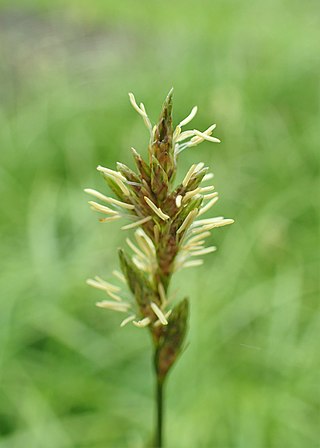
The Cyperaceae are a family of graminoid (grass-like), monocotyledonous flowering plants known as sedges. The family is large, with some 5,500 known species described in about 90 genera, the largest being the "true sedges" genus Carex with over 2,000 species.

Anthyllis vulneraria, the common kidneyvetch, kidney vetch or woundwort is a medicinal plant native to Europe. The name vulneraria means "wound healer".

Anemonoides is a genus of flowering plants in the buttercup family Ranunculaceae. Plants of the genus are native to the temperate regions of the Northern Hemisphere, on the continents of North America, Europe, and Asia. The generic name Anemonoides means "anemone-like", a reminder that many of the species were formerly included within the genus Anemone.

Carex vesicaria is an essentially Holarctic species of sedge known as bladder sedge, inflated sedge, and blister sedge. It has been used to insulate footwear in Norway and among the Sami people, and for basketry in North America.

Carex pilulifera, the pill sedge, is a European species of sedge found in acid heaths, woods and grassland from Macaronesia to Scandinavia. It grows up to 30 cm (12 in) tall, with 2–4 female spikes and 1 male spike in an inflorescence. These stalks bend as the seeds ripen, and the seeds are collected and dispersed by ants of the species Myrmica ruginodis.

Carex cryptolepis, known as northeastern sedge, is a North American species of sedge first described by Kenneth Mackenzie in 1914.

Carex swanii, known as Swan's sedge or downy green sedge, is a species of flowering plant in the family Cyperaceae. It is native to eastern North America.

Carex annectens, sometimes called yellow-fruited fox sedge, is a species of sedge native to most of the eastern United States and southeastern Canada. It is common in prairies and high-water table fallow fields. In the Chicago area, its coefficient of conservatism is 3, and in Michigan, it is only 1, indicating its relatively low fidelity to high quality habitats.

Carex lupulina, known as hop sedge or common hop sedge, is a species of sedge native to most of eastern North America.

Carex werdermannii is a species of flowering plant in the sedge family. It is endemic to southern Chile.
Carex × uzenensis is a hybrid species of sedge and is native to Japan. Its parents are Carex forficula and Carex podogyna.

Carex brizoides, the quaking sedge or quaking-grass sedge, is a species in the genus Carex, native to central and southern Europe. Even where it is a native species, in disturbed woodlands it tends to behave invasively, forming a thick layer on the forest floor and reducing species diversity.

Carex vulpina, the true fox sedge, is a species in the genus Carex, native to Europe and western Asia. It is difficult to distinguish it from its close relative Carex otrubae, false fox sedge.

Carex pallescens, called pale sedge, is a widespread species of flowering plant in the genus Carex, native to the northeastern United States, eastern Canada, Iceland, Europe, Tunisia, and western Asia. It has unstable chromosome numbers.

Carex rhizina is a species of Carex.

Carex dioica, the dioecious sedge, is a species of flowering plant in the genus Carex, native to Iceland, the Faroes, Svalbard, nearly all of Europe, western Siberia, and the Altai. It prefers to live in calcareous fens.

Carex loliacea is a species of flowering plant belonging to the family Cyperaceae.

Carex hendersonii, also known as Henderson's sedge or carex de Henderson, is a tussock-forming species of perennial sedge in the family Cyperaceae. It is native to western parts of North America.

Carex dissitiflora is a tussock-forming species of perennial sedge in the family Cyperaceae. It is native to parts of Japan and Taiwan.

Carex dolichophylla is a species of flowering plant in the family Cyperceae. It is a pernnial herb endemic to southern Chile. It belongs to the Carex subg. Uncinia, one of the six currently recognized Carex subgenera, that corresponds to the now defunct genus Uncinia, formally transferred to Carex on 2015. The species was formerly known as Uncinia macrophyllaSteud.



















